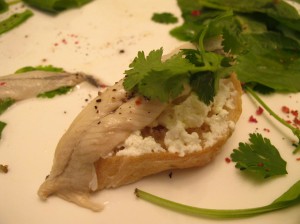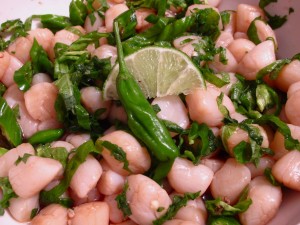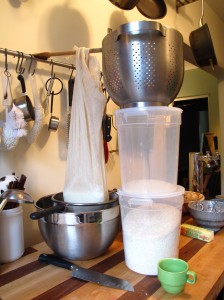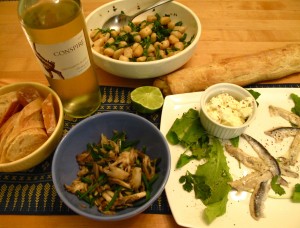Rainy Day Picnic
Just the thought of drinking Sauvignon Blanc makes me want to be outside. Its signature notes of citrus fruits and minerals give it a supreme sense of place, whether the wine originates from the maritime climes of Bordeaux or sunny Marlborough, New Zealand. During a spell of 70-degree weather in New York, I picked up the 2010 Conspire Rutherford Sauvignon Blanc, hedging that the coming weekend would be a warm one. The wine sounded mighty tasty when my colleague, Punky Mahle, described it to me. I opened it on a blue-sky Saturday, and it was just what I needed: a refreshing sip of honeydew and citrus zest with a dollop of cream on the finish. This Sauvignon Blanc screams picnic wine.

Boquerones bruschetta
Barring meat braises and any dish you associate with heaviness, Sauvignon Blanc goes with just about anything. My association with drinking it on a beach or barbecues leads me to veer toward simple fresh fare for pairing with this variety: soft cheeses, arugula salad, ceviche, grilled corn. I didn’t have specific dishes in mind for eating with the Conspire; I just figured I’d make a salad and pick up some chèvre, bread and honey on the way to an afternoon of sipping, snacking and lazing in the park. Although an April shower hit the city by midnight, I convinced myself that it would be all over by the morning.
So, that didn’t happen. The rain continued to fall all Sunday. After a quick, optimistic bike ride in a drizzle that intensified to a pour, my fiancé and I resigned ourselves to staying inside. Never one to shake a fist at the sky, especially when it brings much-needed rain, I whipped out the newest issue of Saveur, whose cover story was about artisanal American bread. I made the four-hour baguette recipe and my fiancé made whole-milk ricotta and a delicious dessert of bakewell tarts with berry compote and almond frangipani. If you’re going to be inside, you may as well try a labor- or time-intensive recipe that you’ve been putting off.
When the table was set and complete with a bowl of sautéed hen of the woods, a plate of boquerones and a dish of baby-scallop ceviche, I poured the first taste of Conspire I’d had since the sunny day before. It was just as delicious, and most impressively, stood up to everything, from the creamy ricotta to the bitter crunch of the almond slivers on the tarts. Picnicking never felt so decadent.
Scallop Ceviche
1 lb. baby scallops

Scallop ceviche with shisito and shiso
2 limes, juiced
1 tbsp. Japanese soy sauce
A healthy pinch of sea salt
10 shiso leaves, chiffonaded
12 shisito peppers, sliced
Mix all but the shiso leaves together and leave to marinate for 30 minutes. Just before serving, mix in the shiso. The shisito peppers can have some bite to them so you might want to seed them to be on the safe side.
Whole-Milk Ricotta
From Artisan Cheese Making at Home by Mary Karlin
Makes 1 lb.
Start to finish: about 1.5 hours: 1 hour to make the cheese, 20-30 minutes to drain

Ricotta just like nonna used to make
1 gallon pasteurized or raw whole cow’s milk
1/2 c. heavy cream
1 tsp. citric acid powder
2 tsp. kosher salt
1) In a non-reactive, heavy 4-quart stockpot, combine the milk, cream, citric acid and 1 teaspoon of the salt and milk thoroughly with a whisk. Place over medium-low heat and slowly heat the milk to 185-195°F. This should take about 15-20 minutes. Stir frequently to prevent scorching.
2) As the milk reaches the desired temperature, you will see the curds start to form. When the curds and whey separate and the whey is yellowish green and just slightly cloudy, remove from the heat. Gently run a thin rubber spatula around the edge of the curds to rotate the mass. Cover the pan and let the curds set without disturbing for 10 minutes.
3) Place a nonreactive strainer over a nonreactive bowl or bucket large enjoy to capture the whey. Line it with clean, damp butter muslin and gently ladle the curds into it. Use a long-handled mesh skimmer to capture the last of the curds. If any curds are stuck to the bottom of the pan, leave them there. You don’t want scorched curds floating in your cheese.
4) Distribute the remaining 1 teaspoon salt over the curds and gently toss the curds with your hands to incorporate. Be careful not to break up the curds in the process.
5) Make a draining sack: Tie two opposite corners of the butter muslin into a knot and repeat with the other two corners. Slip a dowel or wooden spoon under the knots to suspend the bag over the whey-catching receptacle, or suspend it over the kitchen sink using kitchen twine tied around the faucet. Let the curds drain for 20-30 minutes, or until the desired consistency has been reached. If you like moist ricotta, stop draining just as the whey stops dripping. If you like it drier or are using it to make ricotta salata, let the curds drain for a longer period of time. Discard the whey or keep it for another use.
6) Transfer the cheese to a lidded container. Cover and store, refrigerated, for up to 1 week.
The Four-Hour Baguette

Conspiring deliciousness
From Saveur, May 2012, No. 147
1.5 c. (12 oz.) tap water, heated to 115
1 tsp. (1/8 oz.) active dry yeast
3 1/4 c. (14 2/3 oz.) all-purpose flour
1.5 tsp. (3/8 oz.) kosher salt
canola oil for greasing the bowl
1/2 c. ice cubes
1) Whisk together water and yeast in a large bowl; let sit until yeast is foamy, about 10 minutes. Add flour, and stir with a fork until dough forms and all flour is absorbed; let dough sit to allow flour to hydrate, about 20 minutes. Add salt; transfer dough to a lightly floured work surface, and knead until smooth and elastic, about 10 minutes. Transfer dough ball to a lightly greased bowl; cover bowl with plastic wrap, and place bowl in a cold oven. Let dough rest until doubled in size, about 45 minutes.
2) Transfer dough to a lightly floured surface and shape into a 8″ by 6″ rectangle. Fold the 8″ sides toward the middle, then fold the shorter sides toward the center. Return dough, seam side down, to bowl. Cover with plastic again, and return to oven; let sit until doubled in size, about 1 hr.
3) Remove bowl with dough from oven, and place a cast-iron skillet on the bottom rack of oven; position another rack above skillet, and place a baking stone on it.
4) Heat oven to 475°F. Transfer dough to a lightly floured work surface, and cut into three equal pieces; shape each piece into a 14″ rope. Flour a sheet of parchment paper on a rimless baking sheet; place ropes, evenly spaced, on paper. Lift paper between ropes to form pleats; place two tightly rolled kitchen towels under long edges of paper, creating supports for the loaves. Cover loosely with plastic wrap; let sit until it doubles in size, about 50 minutes.
5) Uncover; remove towels, and flatten paper to space out loaves. Using a sharp razor or paring knife, slash the top of each baguette at a 30° angle in four spots, each slash should be about 4″ long. Using the corner of the parchment paper as a guide, slide the loaves still on the parchment paper, onto the baking stone. Place ice cubes in skillet (this produces steam that lets the loaves rise fully before a crust forms). Bake the baguettes until darkly browned and crisp, about 30 minutes; cool before serving.
